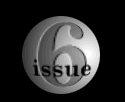The decisive new development took place not in the U.S. but in Italy, where Sergio Leone and Clint Eastwood created the legendary man-with-no-name in a series of stylized Westerns--A Fistful of Dollars, For a Few Dollars More, and The Good, the Bad, and the Ugly. Set in god-forsaken, dry-as-dirt Mexican villages, Leone's films bulge at the seams with unwashed, unshaven outlaws who swagger like Hercules while silently assessing every wallet in town. Eastwood turned his man-with-no-name character into a laconic angel of death. Twisting his shawl to reveal his holster and sucking on a blackened cheroot, he squinted from under his hat's black rim while Ennio Morricone's music cracked like a whip.
 | The opening scene from Once Upon a Time in the West: three gunslingers meet the noon train..
[click photo for larger version] |
Toying with the conventions of the Western like a cat playing with a mouse, Leone stretched time to the absurdist degree. The opening sequence of Once Upon a Time in the West, nearly 15 minutes long, shows nothing more than three gunfighters waiting on a train, but it's one of the great sequences in the history of the Western.
Using the American Westerns Vera Cruz (Robert Aldrich's tale of greed and one-up-manship), 40 Guns (Samuel Fuller's drama of stylistic hysterics, with Barbara Stanwyck leading an army of gunfighters), and The Magnificent Seven (which itself was a remake of Kurosawa's Seven Samurai) as a beginning point, the Europeans treated the Western's conventions with an absurdist exaggeration, in which the Western's traditional idealism was replaced by cynicism and materialism and near super human abilities. The Italian Westerns feature violence taken to parodic extremes. Later movies such as My Name is Nobody pushed even further, where Henry Fonda singlehandedly wipes out an entire army.
The only American filmmakers of this time competing with the Europeans were Monte Hellman and Sam Peckinpah. Hellman (collaborating with Jack Nicholson) produced two great existential Westerns, The Shooting and Ride in the Whirlwind. Peckinpah gave us Major Dundee, The Wild Bunch, The Ballad of Cable Hogue, and Pat Garrett and Billy the Kid. Peckinpah's The Wild Bunch remains the classic American Western of the late '60s. Alternately reviled and praised for its blood splattered, slow-motion scenes of extreme violence, The Wild Bunch grabbed the attention of critics and audiences alike.
 | Ben Johnson, Warren Oates, William Holden, and Ernest Borgnine march to the final showdown in Sam Peckinpah's The Wild Bunch.
[click photo for larger version] |
"I wanted to show what the hell it feels like to get shot," said Sam Peckinpah. The heroes of The Wild Bunch are aging outlaws who refuse to change, even if change means survival. The movie's slow-motion violence is undeniably brutal, but it allows the movie’s over-the-hill heroes to end their lives with one final blast of glory. And thanks to the magisterial wide-screen images of cinematographer Lucien Ballard the film becomes a beautiful elegy for the Western itself.
Some good Westerns would still be made after The Wild Bunch, but much of the old spirit was gone. And the new Westerns, either opting for mud-and-rags realism or parodic excess, failed to find audiences--with one notable exception, the films of Clint Eastwood.
After his Spaghetti Westerns, Eastwood contributed two additional movies in the man-with-no-name mold, Hang 'em High and High Plains Drifter. These Westerns provided a particularly vicious brand of violence, as if to apologize for being Westerns. These films were box-office hits, but the strongest indication of the future came in Coogan's Bluff, where Clint Eastwood's Arizona deputy must go to New York to bring back an escaped killer. Transposing the man-with-no-name to modern times and giving him a respectable vocation, the stage was set for Eastwood to become Dirty Harry. After High Plains Drifter, Eastwood appeared in only two Westerns in the next twenty years.
As the '70s wore on, a group of revisionist Westerns appeared that stripped away the myths to reveal the muddy realities of life on the frontier, including Culpepper Cattle Co., Great Northfield Minnesota Raid, and The Long Riders. With these mud-and-rags Westerns, the genre's characteristic optimism turned into despair.
 | Director William Fraker's painterly compositions in Monte Walsh recall the work of Frederick Remington and other Western artists..
[click photo for larger version] |
Everywhere, the theme of the death of the West took hold. Movies such as Tom Horn and The Shootist (John Wayne's final movie) played out the death of the gunfighter. Monte Walsh examines what happened to cowboys when their skills were superseded by technology: some drifted into crime; Monte Walsh himself (Lee Marvin) is offered a job as a circus performer. Turning the offer down, he comments: "I'm not gonna spit on my whole life." With The Ballad of Cable Hogue the hero dies beneath the wheels of an automobile, further symbolizing the death of the West.
But the death of the West wasn't simply figurative, for the filmmakers and stars were dying. Leaving us in the '70s were John Ford, Howard Hawks, Henry Hathaway, Henry King, Jacques Tourneur, Raoul Walsh, Delmer Daves, and King Vidor. John Wayne died in 1979 and with him a large part of America's faith in the Western. Without the participation of these old masters who really knew the West, the new movies become second hand stories, homages with little life or vitality of their own. And after Heaven's Gate (the most expensive movie of its time) failed miserably at the box office, Hollywood declared the Western to be box-office poison.





